Vol. 2, No. 7
Table of Contents
Feline Nutrition: The Good Carbohydrates
Assist Feeding: Is Bert’s Tummy Full? Part II
Kitty Potpourri: The Purr-fect Potty
Best Cat Food: Katz-N-Flocken
Caring for Cats: Proactive Plan: Step-3
Feline Nutrition
The Good Carbohydrates
by Garry White
W-a-h-h-h!
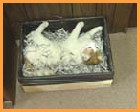 I’ve said all along that Wilbur is a screwball, and now I have proof! Clark was eating cat litter, so I had to make this special litter box for him with shredded newspapers. In answer to the question you haven’t asked yet, Yes, Clark had used the box before Wilbur became so fascinated with it!
I’ve said all along that Wilbur is a screwball, and now I have proof! Clark was eating cat litter, so I had to make this special litter box for him with shredded newspapers. In answer to the question you haven’t asked yet, Yes, Clark had used the box before Wilbur became so fascinated with it!
Okay, that’s enough about screwballs; let’s discuss something more sensible, like oligosaccharides. Actually, that’s just a cute name for inulin, which is a type of non-digestible carbohydrate.
Do we want inulin in Kitty’s diet?
We do.
Why?
Glad you asked: The interesting thing about inulin is this: Unlike most other carbs, inulin is fermented in the lower parts of the intestinal tract. My research describes it as micro flora (bifidobacterium), but if it’s all the same to you, I’ll explain it this way: Inulin helps nourish the “good bacteria” for better digestion, and hinders the growth of infectious bacteria.
Does inulin offer other benefits?
Plenty! The research one could do on this neat little herb goes on to infinity, but let me hi-lite a few of the notable things I ran across:
- Helps keep the lower digestive tract stabilized for better bowel movement
- Improved fat metabolism; possible reduction in the risk of colon cancer (in humans)
- Aids in the absorption of calcium
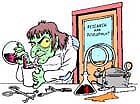
- “Because there is a correlation between average serum lipid level and the incidence of cardiovascular disease (CVD), inulin laden foods could prove a tool in preventing Cardio vascular disease.”
- Possible cancer deterrent: “Bifidobacteria digest inulin to produce short chain fatty-acids, such as acetic, propionic, and butyric acid has cancer- preventing properties within the intestine.”
Okay, so where do we find this ‘inulin’ stuff?
Why, at the inulin store! Uhh.no, that’s not right. Inulin is found in a wide variety of well-known herb roots, but the most common source we see is Chicory root.
So the bottom line is that we want to be pleased when we see Chicory root in that list of ingredients, and now we know why it’s there.
Assist Feeding
Does Bert have a Full Tummy – Part II
by Kathy Fatheree
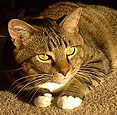 Last week… Bert’s Mom explained to us how they check Bert’s tummy to see if he is still full from the previous feeding. or if Bert is starting to get hungry and ready for his next feeding. Since this topic of checking for a full tummy is so important with tube feeding, I thought I should contact Bert’s Mom for more insight on this ‘aspirate’ procedure!
Last week… Bert’s Mom explained to us how they check Bert’s tummy to see if he is still full from the previous feeding. or if Bert is starting to get hungry and ready for his next feeding. Since this topic of checking for a full tummy is so important with tube feeding, I thought I should contact Bert’s Mom for more insight on this ‘aspirate’ procedure!
Here’s what Bert’s Mom had to say:
It’s funny, when Bert first came home I told my husband Mitch the two things that he would have to do were aspirate him and clean the tube site. For some reason, the thought of both of those just turned my stomach. The first night Mitch went to clean the site, I got too curious and watched him. Well… as he was cleaning it I got bossy and decided I could do a better job and ended up doing it myself! 😀 (Unfortunately I’m a perfectionist, my poor husband has had to learn to live with me!) The same thing went for the aspirating. He was doing it and I came in to watch and it didn’t gross me out like I thought it would. Since I feed Bert 99% of the time anyway, I had to get used to doing it. Yeah, it’s a bit weird. I always feel like I’m making him sick, I mean how does that feel? To have that food pulled out of his stomach!? He doesn’t seem to mind it though and as long as we go very slow he never gets sick from it. It is gross though, the food is on it’s way to being digested so it’s not a pretty site to pull it up into the syringe, but it’s a necessary evil I suppose. This procedure has really helped us as we increase the amount of food we feed him. With this procedure, we are able to make sure that he is ready for more food without over filling him. (He sounds like a gas tank! LOL!) Of everything we do with the tube feeding, the suction on the tube is probably the hardest thing to work with.
A Note about the Spongy Stomach
We were having some issues about a week ago with the syringes clogging when we fed Bert. I called LaLania and that’s when she told me about the stomach sort of folding over. She said it’s a very spongy type organ and that it can sometimes clog the end of the tube. Since the tube is long with a ball with holes on the end, it can cover those little holes and make it hard to feed. She said as long as we can feed him (even if we have to push HARD on the plunger) then he should be okay. We learned to just push a little harder and we haven’t had any issues again. Another thing we did to help with the plunger on the syringe is to put a little olive oil on it as a lubricant. LaLania said that it’s completely safe for Bert and really helps keep the plunger sliding down, and she’s right! It really helps!
…Be sure to check in next week to follow Bert’s journey!
Kitty Potpourri
The Purr-fect Potty
by Dan Malenski
This week, I will talk about some of the new bathroom facilities available for our cats when they feel it is time to powder their noses. Although we will mention the basic litter pan, we will focus on some of the commercial products available, which are designed to make kitty’s bathroom like part of your living room and make your neighbors green with envy. Gone are the days when the only thing available for this purpose was a (shudder) plain polypropylene pan, as we now have kitty bathroom facilities that are of furniture quality and have the same price tag. I must confess that Amanda and Melissa use standard bathroom facilities in our home, that is, two large, polypropylene pans with hoods. I am writing this article without their knowledge, lest I be faced with a non-negotiable demand for new bathroom facilities that would force me to take a second mortgage on the house.
Since all of us are familiar with the ubiquitous litter pans sold for cats, I will mention an alternative for those who need a very spacious pan for a cat nearly the size of a small pony, for which even the largest size available in your pet store will not do. A good alternate may be to use what restaurants use to tote dirty dishes from the serving area back to  the kitchen. I’m sure that everyone had seen these huge poly pans at one time or another, but may not have thought that they also make world class litter pans! People generally visit restaurants for a dining experience and do not have cat litter on their minds. They are available in many sizes, easily washed, have large rounded edges, and are sturdy enough to tussle with a runaway SUV and win! You will find these inexpensive trays where restaurant supplies are sold under the names of tote boxes, bus boxes, or bus pans.
the kitchen. I’m sure that everyone had seen these huge poly pans at one time or another, but may not have thought that they also make world class litter pans! People generally visit restaurants for a dining experience and do not have cat litter on their minds. They are available in many sizes, easily washed, have large rounded edges, and are sturdy enough to tussle with a runaway SUV and win! You will find these inexpensive trays where restaurant supplies are sold under the names of tote boxes, bus boxes, or bus pans.
For those cats that must have the finer things in life, there are furniture quality enclosures available that will blend in with any home décor. They are available pre-stained or unfinished and may hold one or two large litter pans. The front of the cabinet looks like any piece of furniture, and nearly all of them have an entrance hole in one of the sides.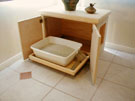 The entrance hole may be made less conspicuous by placing the side with the entrance hole next to a wall or other piece of furniture. The front of the cabinet opens up, and the litter pan sits on a shelf that easily rolls out for ease of cleaning. The prices for this category range from about $50.00 to $150.00, with the higher ranges reserved for the better ones, which are suitable for any living room.
The entrance hole may be made less conspicuous by placing the side with the entrance hole next to a wall or other piece of furniture. The front of the cabinet opens up, and the litter pan sits on a shelf that easily rolls out for ease of cleaning. The prices for this category range from about $50.00 to $150.00, with the higher ranges reserved for the better ones, which are suitable for any living room.
Finally, for those cats who demand the absolute finest, there are cabinets that will hold more than one litter pan and many are of dual use, that is, the lower portion houses the litter pan(s), and the top portion contains shelves that may be used for any suitable purpose. Cabinets in this category are also available with doors mounted on the upper portion that may be of various styles. Some doors are plain, while others may contain a stained glass pattern or even a hand carved pattern at extra cost. Cabinets in this category are priced from the area of $600.00 and up. You could purchase a large unit, such as the ones described here and easily pay a price in the four-figure category with the various options offered. You may ask if you still have to clean the litter pans, and the answer is yes!
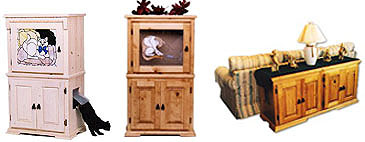
You may find some of the more inexpensive cabinets at some of the larger pet stores, but for the most part, you will find the largest selection on the internet via your favorite search engine, using the key words of cat, litter, and cabinet. You will find some that will also build cabinets customized to your specifications from the ground up and leave you with a depleted wallet or purse. No matter how expensive, I could not find any that provided a maid with it, and the closest one to it was one particular model that was built to accept the Littermaid® self-cleaning litter box at additional cost.
Food of the Week
Katz-N-Flocken
by Garry White
Each week we are having our own cat food reviews to determine what we, or should I say, our kitties think is the best cat food.
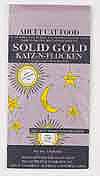
Brand Name: Solid Gold
Product: Katz-N-Flocken
Type: Dry
Our Rating: ![]()
Kitty Rating: ![]()
Kitty Comments:
“Grzvich hrat mlopka!”
Our Comments:
“Don’t talk with your mouth full, Son!” But listen, I’m not chewing anything at the moment, so I’ll talk about the quality of this food: Very top-notch, folks! One can only be highly impressed with the thought and consideration that goes into the ingredients. For example, they use Menhaden fish-meal; Menhaden, from the Herring family, is a middle-feeder that doesn’t eat the scum off the top or the sludge off the bottom. But that’s just one; their claim is that all ingredients are human-grade foods! Plenty of protein, and a fantastic nutrient balance. Kathy and I have fed Solid Gold to our cats for quite a while, and they seem to love it. A call to these folks will tell you immediately that you’re talking to people who are extremely confident in the quality of their products. The company also offers a pretty good line of treats, supplements, and coat-care products, and you’ll see Solid Gold in most pet-food stores (and you’ll see them on here again from time to time, too). You’ll love their website; lots of great information there.”
Manufacturer Says:
“Katz-N-Flocken was the first natural cat food in the United States. Historically made with lamb, brown rice, barley, menhaden fish, and healthy oils such as flaxseed oil and canola oil, this product is especially helpful for cats with skin problems, allergies, and digestive problems. Katz-N-Flocken does not contain any corn, wheat, soy, chemical preservatives, added sugar and salt, or chemical preservatives, which are often implicated in a myriad of problems including poor coat and digestive upset.
We have recently made this great product even better with the addition of fresh lamb, antibiotic free chicken meal, and chicory root. Chicken meal reduces the overall ash content of the product, which helps protect against urinary tract problems.
Katz-N-Flocken is packaged in 4 lb and 15 lb hermetically sealed foil bags, which help preserve the freshness of food without the addition of chemical preservatives.
For a free sample of Katz-N-Flocken, please contact our corporate offices at 800-364-4863.
Website: http://www.solidgoldhealth.com
Phone: 1-800-364-4863

Caring for Cats
Proactive Plan: Step-3
by Garry White
Observing Fluffy’s routine habits
Given enough space, I could write a dozen pages on the importance of tracking (and recording!) their habits and routines over the days, months, years. This alone is probably one of the best tools we have for catching a problem in its infancy stages. We’ll talk about some of the important things a kitty’s behavior (habits, routines) can tell us, but first we’ll set the stage so that what we’re observing makes sense.
We’re often wrong in our interpretation of why a kitty does some of the things it does. Covering their stuff in the box, for example, is often seen as good household manners.”Oh, my kitty is so clean!” That may be true, but covering his/her stuff is instinctual; it keeps predators from tracking their scent. At least that’s the theory, but if you’ve had Cat-A cover up stuff Cat-B left in the box (as I have personally witnessed), that theory is up for challenge, right? No, not really: What I witnessed was an act of instinct from Cat-A, and a show of affection for Cat-B!
As long as we’re on the subjects of instinct and nature, let’s see how it relates to illnesses and pain, and this is one you want to read carefully. We all know that cats will hide a problem, and you’ve seen me write many times that a condition is often 70-80% into progression before we even know something is wrong! Rotten little sneaks, huh? Well, not really. Remembering that cats came from the wild, they aren’t intentionally keeping bad secrets from us; nature (and ancestry) has shown them that exposing weakness –sickness, pain, injury– invites attack from predators.so by instinct they don’t show pain until it’s unavoidable. Sidebar: This business of self-preservation is instinctual in humans, too, and if you doubt what I say, try this: Pop a loud balloon in a crowded room and note how many people throw their hands up to cover their ears.and then note how many people attempted to cover your ears. Nope, nature forces us to take care of ourselves first. That’s just how it works, and there isn’t a thing we (or kitties) could do to change that.
So it would seem that the potential for early detection is slim, wouldn’t it? I mean, nature is against us, here. Wrong again; nature works in our favor, too! Instinct will tell her to go hide, so that her pain or suffering (weakness) isn’t visible to potential predators. AHA, there’s a sign! The same instinct will tell her brain, “We’re sick today, not hungry.” AHA, poor appetite; another sign! Playfulness will wane, curiosity will disappear, instinct will tell her “we’re sick, we’re hurting; these things aren’t important right now.”
The signs are there for us to see, but we have to understand that they aren’t blatant and flashing. We also have to understand –and this is the most important thing of all– that any sign by itself is often meaningless. Fluffy being grumpy for a day means nothing. Fluffy being grumpy for a week (and getting grumpier by the day) means everything!
Disclaimer: Kathy Fatheree is not at all a medical expert. Contents of this web site are a collection of Kathy’s assist feeding experiences as well as the experiences of other cat owners who have assist fed their cats. While every effort has been made to ensure the accuracy of the information, Kathy Fatheree or anyone associated with this web site cannot be held responsible for anything that may happen as a result of using the information on this site.
